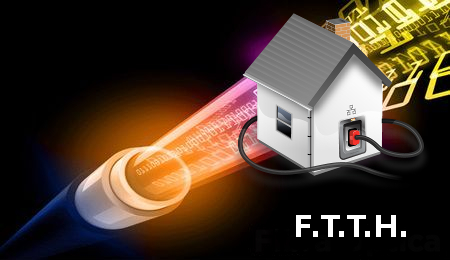FTTH (Fiber to the Home) is a form of fiber optic communication delivery in which the optical fiber reached the end users home or office space from the local exchange (service provider). FTTH was first introduced in 1999 and Japan was the first country to launch a major FTTH program. Now the deployment of FTTH is increasing rapidly. There are more than 100 million consumers use direct fiber optic connections worldwide. Why does FTTH develop so rapidly?
FTTH is a reliable and efficient technology which holds many advantages such as high bandwidth, low cost, fast speed and so on. This is why it is so popular with people and develops so rapidly. Now, let’s take a look at its advantages in the following.

- The most important benefit to FTTH is that it delivers high bandwidth and is a reliable and efficient technology. In a network, bandwidth is the ability to carry information. The more bandwidth, the more information can be carried in a given amount of time. Experts from FTTH Council say that FTTH is the only technology to meet consumers’ high bandwidth demands.
- Even though FTTH can provide the greatly enhanced bandwidth, the cost is not very high. According to the FTTH Council, cable companies spent $84 billion to pass almost 100 million households a decade ago with lower bandwidth and lower reliability. But it costs much less in today’s dollars to wire these households with FTTH technology.
- FTTH can provide faster connection speeds and larger carrying capacity than twisted pair conductors. For example, a single copper pair conductor can only carry six phone calls, while a single fiber pair can carry more than 2.5 million phone calls simultaneously. More and more companies from different business areas are installing it in thousands of locations all over the world.
- FTTH is also the only technology that can handle the futuristic internet uses when 3D “holographic” high-definition television and games (products already in use in industry, and on the drawing boards at big consumer electronics firms) will be in everyday use in households around the world. Think 20 to 30 Gigabits per second in a decade. No current technologies can reach this purpose.
- The FTTH broadband connection will bring about the creation of new products as they open new possibilities for data transmission rate. Just as some items that now may seem very common were not even on the drawing board 5 or 10 years ago, such as mobile video, iPods, HDTV, telemedicine, remote pet monitoring and thousands of other products. FTTH broadband connections will inspire new products and services and could open entire new sectors in the business world, experts at the FTTH Council say.
- FTTH broadband connections will also allow consumers to “bundle” their communications services. For example, a consumer could receive telephone, video, audio, television and just about any other kind of digital data stream using a simple FTTH broadband connection. This arrangement would more cost-effective and simpler than receiving those services via different lines.
As the demand for broadband capacity continues to grow, it’s likely governments and private developers will do more to bring FTTH broadband connections to more homes. According to a report, Asian countries tend to outpace the rest of the world in FTTH market penetration. Because governments of Asia Pacific countries have made FTTH broadband connections an important strategic consideration in building their infrastructure. South Korea, one of Asian countries, is a world leader with more than 31 percent of its households boasting FTTH broadband connections. Other countries like Japan, the United States, and some western countries are also building their FTTH broadband connections network largely. It’s an inevitable trend that FTTH will continue to grow worldwide.
Originally published at www.china-cable-suppliers.com/why-does-ftth-develop-so-rapidly
